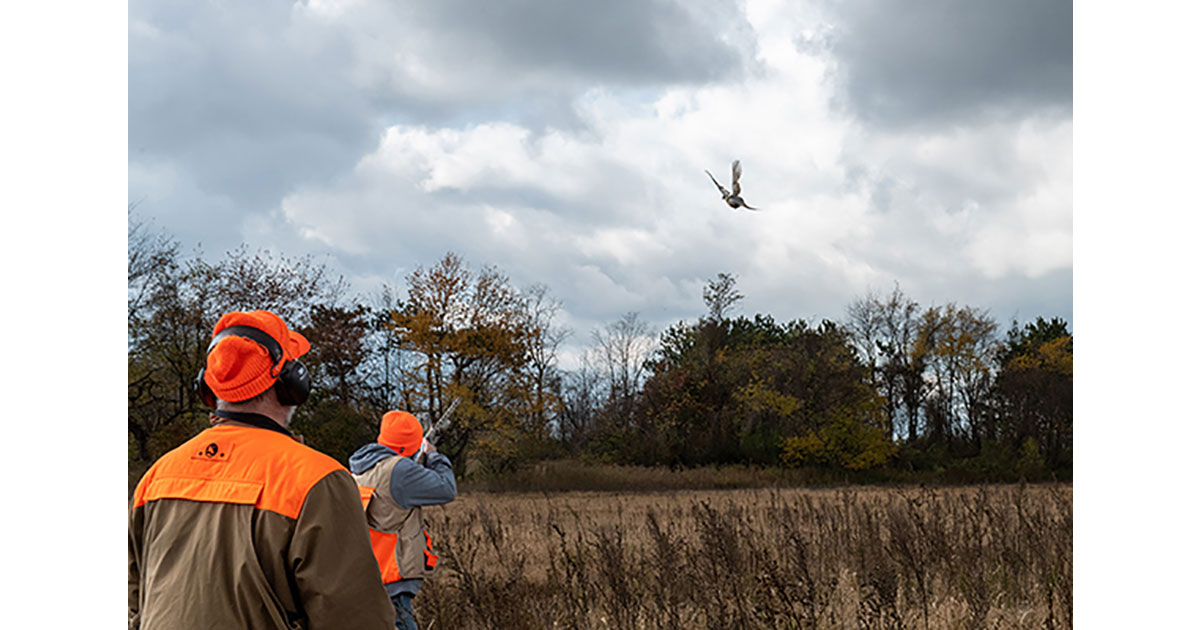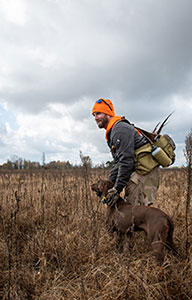By ADAM BUMP, Upland gamebird specialist
Michigan Department of Natural Resources
 Michigan Pheasant hunting
Michigan Pheasant hunting
Although many may have trouble believing it now, the opening day of ring-necked pheasant hunting was once like opening day of deer season in Michigan.
Thousands looked forward to mid-October. People planned vacation days in advance to make sure they could hit the farm fields and grasslands. Kids skipped sitting in classrooms for a chance to hear the burst of strong wings and the telltale cackle of a pheasant rooster.
Pheasant hunting was king for many hunters in Michigan’s farmlands.
There are still many active hunters, although admittedly a bit slower-moving and probably with a few gray hairs (at least), who remember the heyday of hunting wild pheasants here.
In 1944, Michigan’s pheasant harvest topped 1.4 million birds. An average of over 1 million birds were harvested each year from 1937-1959. Small game hunters during that same time numbered between 500,000 and 700,000.
Sadly, over the past seven decades, wild pheasant numbers have declined in the state.
This change was predictable, as Michigan’s agricultural landscape looks nothing like it did in the 1940s and 50s.
Back then, farm country was expansive. Few tillable acres in the southern third of the state were not actively farmed. Even some areas that were difficult or impossible to be farmed were still under the plow or under hoof and being used as pasture for cattle, sheep and other livestock.
Farms had smaller fields, with grassy or shrubby fencerows dividing those fields. Many different types of small grains were grown, rather than the modern landscape of large fields with corn, soybeans and wheat dominating Michigan’s croplands.
Farming practices were different too.
Farming practices were less efficient, and leftover grain and some wildlife cover often remained in the fields. Some farms still used fallow fields in their rotation, giving fields a rest from growing grain crops and allowing those fields to go unworked for a year or more – inadvertently providing food and nesting cover for pheasants.
As practices slowly changed, and as some fields were abandoned and eventually matured into forests, pheasant numbers declined.
In 2017, the Michigan Department of Natural Resources estimated that 12,855 pheasants were taken in the hunting season by only 16,443 pheasant hunters. A far cry from the peak in the 1940s.
The DNR has been actively managing habitat and is a primary member of the former Michigan Pheasant Restoration Initiative (now the Michigan Grassland Coalition), co-chairing the group with Pheasants Forever.
This coalition partners with agencies, nongovernmental organizations, landowners and others to promote the enhancement and creation of grasslands for the benefit of pheasants and other grassland species.
While the Michigan Pheasant Restoration Initiative has been successful and the state continues to have huntable populations of pheasants scattered throughout the southern Lower Peninsula, habitat work is not able to return the abundance of pheasants we once had when conditions were ideal.
What about those ‘good old days’?
In the late 2010s, discussions began about ways to try to recapture the high-point days of Michigan pheasant hunting.
Landscape-scale habitat changes are not achievable, so how could the DNR bring back the experience of hunting abundant pheasants?
The goal was to provide some nostalgia for those old enough to have experienced high numbers of wild birds and to provide access to high pheasant numbers for new hunters.
A pilot program was funded through legislation and conducted in 2019. The focus was on providing excellent hunting opportunities rather than increasing populations.
This focus was emphasized by the decision to include only male pheasants for the release program, maximizing the number of birds available for hunting.
This decision has been controversial, as some support releasing hens to attempt to increase wild bird populations. However, pheasant releases seldom result in pheasant numbers increased.
Habitat work has remained the central focus of wild pheasant population enhancement efforts.
The release program began and continues as a partnership with the Michigan Association of Game Bird Breeders and Hunting Preserves.
In the pilot year, releases occurred on 13 state game areas in southern Michigan.
The program had strong support from a number of individuals and saw participation from an estimated 2,841 hunters spending a total of over 11,000 days pursuing released pheasants.
The program was put on hold in 2020 due to the coronavirus pandemic.
In 2021, legislation passed that created a new pheasant license to fund the release program. The license is required for public-land pheasant hunters, with a few exceptions.
Details can be found on the DNR website.
The program allows for releases of pheasants on suitable public lands for pheasant hunting purposes. Currently, the program is focused on public lands in southern Michigan, which represents the core of former pheasant range.
While some flexibility exists, it is likely the program will remain focused on southern Michigan habitats for the foreseeable future.M/p>
The new program’s first year occurred in 2021, funded by money left over from the 2019 pilot program. In 2022, the program was funded by license fees.
Over 2,000 birds were released at nine areas in southern Michigan. This program was smaller than previous years due to funding limitations, but both 2021 and 2022 were successful in providing opportunities for hunters to reconnect and share some experience with old and new friends and allow new hunters to enjoy pheasant hunting similar to conditions present decades ago.
Supporters of the program feel the releases have been tremendously successful and again look forward to mid-October to get out to hunt, knowing they have a great chance at finding pheasants in the public-land grasslands of southern Michigan.
How about 2023?
This fall, hunters will have the opportunity to pursue released rooster pheasants on 13 state game areas spread across southern Michigan. Over 6,000 roosters will be released, beginning just before the Oct. 20 opening day of hunting season and continuing throughout the early and late seasons for all release areas with a late season.
Funding for this year will total $150,000, which is triple the amount spent in 2022. The results will be more birds and more locations for a longer season. Consequently, 2023 is a great year to try out the pheasant release program if you haven’t already!
Releases will occur on the following state game and wildlife areas:
- Cass City State Game Area (Tuscola County). NEW
- Cornish State Game Area (Cass County).
- Crane Pond State Game Area (Cass County). NEW
- Crow Island State Game Area (Bay and Saginaw counties).
- Dansville State Game Area (Ingham County). NEW
- Erie State Game Area (Monroe County).
- Lapeer State Game Area (Lapeer County).
- Leidy Lake State Game Area (St. Joseph County).
- Pinconning State Game Area (Bay County).
- Pointe Mouillee State Game Area (Monroe and Wayne counties).
- Rose Lake State Wildlife Area (Clinton and Shiawassee counties).
- St Johns Marsh State Wildlife Area (St. Clair County). New: expanded release area in December.
- Stanton State Game Area (Montcalm County). NEW
 Michigan pheasant hunterRelease sites have been selected based on the availability of suitable pheasant habitat as well as the appropriate conditions for a release area. The intent of the program is to retain some of the traditional feel of wild bird hunting, so DNR staffers do not provide specific release locations or release times.
Michigan pheasant hunterRelease sites have been selected based on the availability of suitable pheasant habitat as well as the appropriate conditions for a release area. The intent of the program is to retain some of the traditional feel of wild bird hunting, so DNR staffers do not provide specific release locations or release times.
However, birds will be released throughout the seasons at each area. Parking lots near release locations typically have signs indicating there is a release site nearby and provide contact information about the pheasant breeder providing the birds for that specific site, in case hunters wish to inquire about additional hunting opportunities at breeder hunting preserves.
All regular hunting regulations apply. Only male birds may be harvested, with a bag limit of two per day, four in possession. A special pheasant license is required in addition to a base license.
Through these relatively recent pheasant habitat and hunting opportunity improvement efforts, the DNR and its partners hope they have brought back at least a bit of what it felt like to experience ring-necked pheasant hunting, back in those halcyon days when the sport reigned king in southern Michigan.